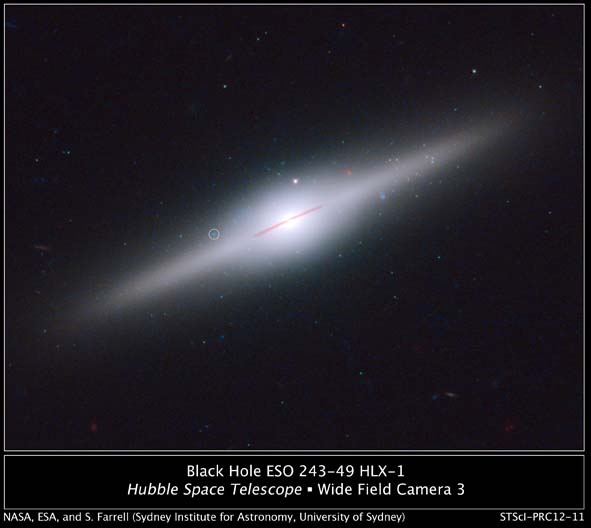
Using the XMM-Newton X-ray space telescope, astronomers have detected a globular star cluster that lies above the plane of an edge-on spiral galaxy and contains an X-ray source which they believe to be an intermediate-sized black hole (see small circle in above image). They believe it must have come from a dwarf galaxy that has somehow had all of it’s stars stripped away in the process of being accreted by the spiral galaxy. They infer from cluster’s colors that a population of hot blue stars must encircle the X-ray source along with a population of cooler redder stars.
http://www.physorg.com/news/2012-02-black-hole-shredded-galaxy.html
Is this not an example of a massive core star being ejected from the parent galaxy, which is growing a surrounding cluster of stars as it begins the process of growing into a daughter satellite galaxy? The presence of the ‘young’ hot stars is consistent with recent observations of ‘blue stragglers’ within ancient star clusters.
http://www.physorg.com/news/2012-02-young-stars-home-ancient-cluster.html
And could not the redder colors observed be due in part to the gravitational influence of the 20,000 solar mass core star?
———————————–
Response to the questions of gmagee: The conclusion that this source originated from an incoming dwarf galaxy that has had its stars tidally stripped away is largely incorrect for no stream of stripped away stars is evident in this photo. As gmagee suggests, this source most likely originated from the core of this galaxy ( ESO 243-49 ) through a matter ejection event. Such matter creation and ejection is predicted by subquantum kinetics, and the existence of the phenomenon was earlier proposed by astronomers such as Ambartsumian and Arp to explain observations of active galactic nuclei. So this star cluster may be regarded as a galactic core ejection that will one day grow into a dwarf elliptical daughter galaxy orbiting this spiral. Evidence that galactic cores eject globular star clusters has been discussed in a previous posting (http://starburstfound.org/sqkblog/?p=271).
Also the conclusion that this 20,000 solar mass X-ray source is a black hole is incorrect. As discussed in a previous posting (http://starburstfound.org/sqkblog/?p=115), and in the book Subquantum Kinetics, black holes should be unable to form. Particle scattering experiments have shown that the electric field at the center of the nucleon is bell-shaped, not spiked to an infinite point value. And, due to electrogravitic coupling, we may assume that its gravity field is similarly bell-shaped. Hence gravitational singularities are unable to form if there were any collapse. Anyway the outpouring of genic energy from a massive star prevents any core collapse. So, this above-plane globular cluster X-ray emitting source is more likely a supermassive mother star of finite diameter, not a black hole singularity. It would have a very high mass density similar to that of a white dwarf.
The redish color seen in the cluster is not due to gravitational redshifting, but most likely comes from low mass stars in the cluster whose color is typically red. Such stars continually form and grow in the cluster from gas that is being expelled by the mother star core. The blue color that is observed comes from more massive and hotter stars such as blue giants, blue supergiants, and Wolf-Rayet stars. Yes, such “blue stragglers” are seen in other globular clusters such as the nearby cluster NGC 6752 discussed in the link above. The presence of such blue stars is a mystery for many astronomers because standard theory places their age at only millions of years whereas the red star population is typically believed to have an age of 10 billion years or so as in the case of NGC 6752. So they wonder why young stars would form in an old cluster. There is no such problem in the cosmology of subquantum kinetics. SQK predicts that low mass reddish stars continually grow in size through matter creation and accretion and eventually transform into the more massive blue stars. So these blue stars are not young, but actually the oldest and most evolved in the cluster. Such mature bluish stars are also found to surround our own Galaxy’s core.
Paul LaViolette, 2-22-12

A large population of red giant ‘rogue’ stars has been found at the edges of the Milky Way. Astronomers conclude that they must have originated at the galactic core, and been ejected therefrom at hypervelocities. Nevertheless, they note that the stars must have grown significantly over their journeys. Is is likely that most of these stars were ejected at hypervelocities, or could many of them simply grown large and old on a typical migration from the central region of the galaxy?
http://phys.org/news/2012-04-rogue-stars-ejected-galaxy-intergalactic.html
http://phys.org/news/2010-11-milky-stars-mysterious-ways.html
Of further note, is the discovery of a dwarf cluster of stars deep in intergalactic space. Is this an example of the intermediate stage between a rogue star ejection and the fomation of a satellite ‘daughter’ galaxy?
http://phys.org/news/2012-04-ridiculously-dim-bevy-stars-milky.html